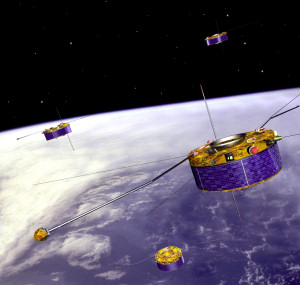Cluster Science Data System (CSDS)
Structure of the CSDS Ring
To access the Cluster science data, please select one of the data centres (indicated in blue):
 |
About CSDS
The Cluster Science Data System (CSDS) is an integral part of ESA's Cluster Mission to the Earth's magnetosphere.
 |
Since Cluster consists of 11 different experiments, each one managed by a separate Principal Investigator and his/her team, the problem of data exchange among the experimenter groups is not a trivial one. High-quality, fully validated data is something that each team wishes to keep under strict control in order to avoid misuse and misinterpretations. On the other hand, rapid data exchange among the teams is vital for a complete understanding of the complex processes to be studied by Cluster; each team needs the data from the others to properly analyse its own. (See the text from the Final Report of the CSDS Working Group, below under "Purpose".)
To fulfil this requirement, the Cluster Science Working Team along with the ESA Cluster Project Team have established the Cluster Science Data System CSDS, a distributed set of data centres, most of which are associated with one or more of the Cluster experiments. With software provided by the experiment team, each data centre processes the data for "its" experiments, and then exchanges them with all the other centres to obtain a full set in a standard format. See the clikable map of the CSDS Ring above for the data centres and for accessing the data.
The data sets that are provided include:
-
Prime Parameter Database (PPDB)
A set of parameters from all four spacecraft averaged over one spin (about 4 seconds); these data are publicly available. -
Quicklook Plots
Plots of several key plasma parameters for one, and up to four spacecraft, in printable format (GIF); these data are publicly available.
The plots are primarily intended for event identification and mission monitoring (best time resolution is one minute). They are not guaranteed to contain best-calibrated science data, but are indicative of general in-situ plasma conditions crossed by the spacecraft, and are usually available online within a few hours of data being received on the ground. -
Summary Parameter Database (SPDB)
A set of parameters from one spacecraft with one minute resolution. These include auxiliary parameters (orbit, attitude, configuration, ...) and the data are publicly available. -
JSOC Events Catalogues
A set of predicted scientific and orbital events; the information is publicly available.
A detailed description of CSDS can be found in the CSDS User Guide.
Additional documentation, mainly of interest to those directly involved in CSDS, is also available.
Purpose
The purpose behind CSDS is best explained by this extract from the Final Report of the CSDS Working Group:
|
As part of the Solar-Terrestrial Science Programme (STSP), Cluster is to investigate the small scale and/or transitory phenomena that govern and modulate the transfer of particles and energy between the solar and terrestrial environments. Specific regions of interest include the polar cusp region, the magnetopause (where flux transfer events occur), the bow shock, and the geomagnetic tail. All these regions are the sites of significant in-situ particle acceleration and local dissipative processes that mediate energy and momentum transfer (e.g. magnetic reconnection at the dayside magnetopause resulting in flux transfer events). Thus these time-varying small-scale phenomena are crucial to our understanding of the global solar-terrestrial coupling processes, and provide a unique laboratory for the testing and refining of theories relevant to both laboratory and astrophysical plasmas. The mission objectives will be achieved by launching four identical spacecraft into an eccentric polar orbit. Cluster's unique four-satellite strategy, employing an adjustable tetrahedral configuration, will allow an unambiguous separation of spatial and temporal scales through the inter-comparison of the data from all four spacecraft and many different instruments. This will require substantial data processing, but will enable the calculation of many essential physical quantities, such as curl B, curl v, grad p, and plasma acceleration, for direct input into and comparison with theoretical models. The examination of momentum transfer, for example, at the dayside magnetopause, requires not only the time-dependent 3-D information produced by the four spacecraft formation, but also depends both on plasma parameters (ρ, v, p) and on magnetic field data. At the kinetic level, probing the microscopic behaviour that gives rise to various (anomalous) transport processes demands additional information about the particle distributions and the wave activity. This illustrates that at least one aspect of Cluster science can only be achieved by the use of data from many of the instruments carried by the four spacecraft. This is also true of most of the scientific objectives of the mission and in the various instrument proposals. |
